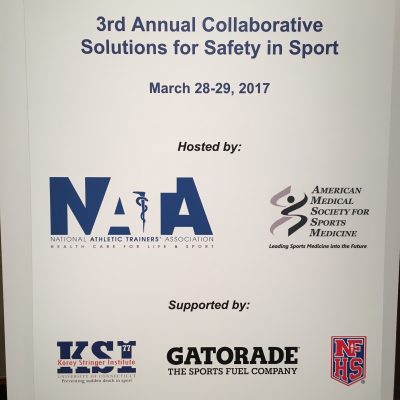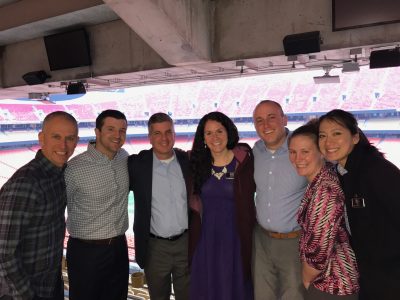William M. Adams, PhD, LAT, ATC Vice President of Sport Safety
March 28-29, 2017 Kansas City, MO
The 3rd annual Collaborative Solutions for Safety in Sport meeting was held last week in Kansas City, MO that brought over 100 individuals representing all 50 states and the District of Columbia together to continue the task of enhancing the health and safety policies for high school athletics. This meeting, hosted by the National Athletic Trainers’ Association and the American Medical Society for Sports Medicine and supported by the Korey Stringer Institute and Gatorade, began out of an idea spawned by Drs. Douglas Casa, PhD, ATC, FACSM, FNATA, FNAK and Jonathan Drezner, MD to make high school sports safer for the participating athletes.

This years’ meeting was constructed so that the attendees decided on the topics to be discussed. Prior to the meeting, all of the attendees were sent a survey that asked them which topics they would either want to learn more about or have in depth discussions about. From the survey, 16 breakout sessions were formed where the attendees who wanted to learn more about one particular topic were able to come together in small groups to have further discussions.
Overall, these breakout sessions were immensely successful as they stimulated many fruitful discussions over the successes, barriers, and other strategies to help develop and implement health and safety policies across the US. It was great to see states that have been successful in implementing change in a certain area (i.e. heat acclimatization) providing feedback and suggestions to states that have not been successful in implementing such policies. These discussions provided great peer-to-peer feedback, which may have been better received for some individuals.
Having attended all of Collaborative Solutions for Safety in Sport meetings over the past three years, it has been amazing to see the efforts taken by leaders within state high school athletics associations and sports medicine advisory committees following the meeting to develop and implement health and safety policies. States like Vermont, Illinois, South Carolina, Utah, New Jersey and many others have taken advantage of these meetings to implement best-practice policies in their state with many crediting the Collaborative Solutions meeting as the event that was the impetus for change.
While many states have made great strides in improving the health and safety of their student athletes, others have remained resistant to change and often citing “We haven’t had anything happen in our state, so there is no reason to change.” We must remember that implementing evidence-based minimum best practice policies such as emergency action plans, heat acclimatization, access to AEDs, environmental-based activity modification guidelines and the management of sport related concussion, cost little to no money to implement and there should be no reason not to take the proactive steps to keeping our young student athletes safe.
Keeping the forward progress mindset and further cultivating relationships between sports medicine advisory committees, high school athletics associations and coaches with the mindset of having the most up-to-date evidence-based policies in place is needed to ensure that our young athletes are protected while playing the sports that they love.